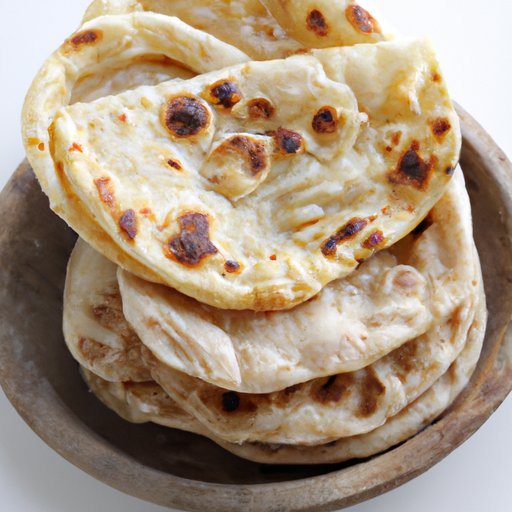
Introduction
Roti is a classic Indian flatbread that has become popular around the world. It is a staple in Indian cuisine and is often served with curries, vegetables, or lentils. Roti is an integral part of Indian culture, and it is an essential recipe to learn if you want to experience the richness of Indian cuisine. In this article, you will learn how to make roti from scratch, including the kneading, rolling, and cooking process. You will also learn about the cultural significance of roti and its history.
Step-by-Step Guide on Making Roti
The process of making roti involves kneading, rolling, and cooking the dough. Follow these simple steps to make delicious and authentic roti:
Section on Kneading the Dough
To make the dough, you will need the following ingredients:
- 2 cups whole wheat flour
- 1 teaspoon salt
- 1 tablespoon oil
- 1 cup lukewarm water (or as needed)
1. In a large mixing bowl, add the flour, salt, and oil. Mix well.
2. Slowly add water and knead until you get a soft, pliable dough. The dough should not be too sticky or too dry.
3. Cover the dough and let it rest for 30 minutes.
Section on Rolling the Dough
1. Divide the dough into small balls about the size of a golf ball.
2. Dust a rolling pin and rolling board with a little flour. Flatten the ball of dough slightly and use the rolling pin to roll it out into a circle. You can also use your hands to stretch out the dough.
3. Optional: Add a little bit of oil or ghee to the rolled-out dough.
Section on Cooking the Roti
1. Heat a tawa, griddle, or pan over medium-high heat.
2. Gently place the roti on the heated surface and cook for 30 seconds or until you see small bubbles appear on the surface.
3. Flip the roti and cook for an additional 30 seconds.
4. Optional: For puffing the roti, use tongs to hold the roti over a low flame until it puffs up. Remove from heat and serve immediately.
5. Brush with a little bit of butter or ghee, if desired.
Video Tutorial for Making Roti
Visual learning can be an excellent way to learn how to make roti. Here’s a great video tutorial that will show you how to make roti with easy-to-follow instructions:
[Insert hyperlink to a video tutorial]
The Cultural Significance of Roti
Roti is not just a delicious food; it is also an essential part of Indian culture. For centuries, roti has been a staple in Indian cuisine, serving as a nutritious and economical food for a population that has had to face food scarcity in the past.
Roti has played a significant role in daily life, social customs, and religious traditions in India. For example, roti is often shared among family members and guests as a symbol of love and respect. Roti is also used as prasad (sacred food) during religious festivals and ceremonies.
Variations and Recipes for Roti
While the traditional whole wheat roti is delicious on its own, there are many different regional variations of roti that you can explore. Here are a few options:
- Stuffed roti (paratha): This type of roti is filled with various ingredients such as potatoes, vegetables, cheese, or meat. The filling is added to the dough before rolling.
- Flavored roti: Adding herbs and spices such as cumin, fennel, and coriander seeds can add a delicious twist to the traditional roti recipe.
There are many different ways to get creative with roti, so don’t be afraid to experiment with different ingredients and flavors.
Expert Tips and Tricks for Making Roti
The process of making roti can be intimidating, but with a few expert tips and tricks, you can perfect your roti-making skills. Here are some commonly overlooked tips:
- Use lukewarm water when making the dough to help activate the gluten in the flour.
- Be sure to rest the dough for at least 30 minutes before rolling it out, as this allows the gluten to develop, making it easier to handle.
- Make sure to keep the dough slightly wet as this will reduce splitting while rolling out the dough.
- If you are new to making roti, start with a simple whole wheat recipe and focus on getting the texture and consistency right before trying more advanced variations.
Conclusion
In conclusion, roti is an essential recipe to learn for both culinary and cultural reasons. It’s easy to make, delicious, and versatile, and you can enjoy it on its own or as a side dish with a variety of curries and vegetable dishes. With this step-by-step guide, you can make delicious roti at home and explore different flavors and variations. So, next time you’re in the mood for Indian cuisine, try making your roti at home and impress your friends and family with your new culinary skills.





